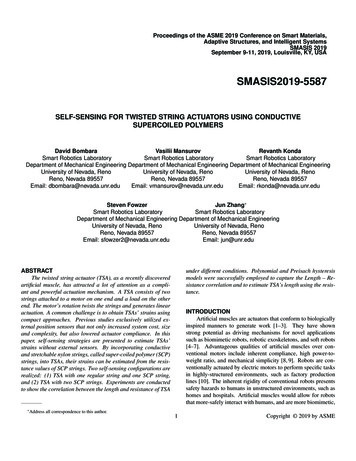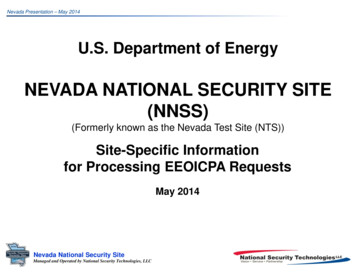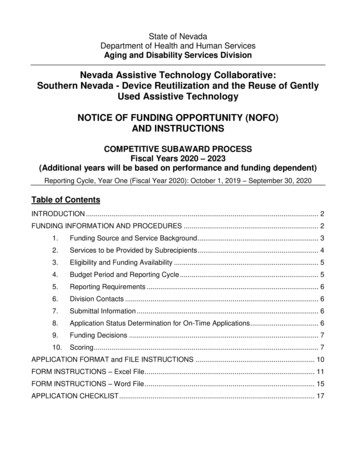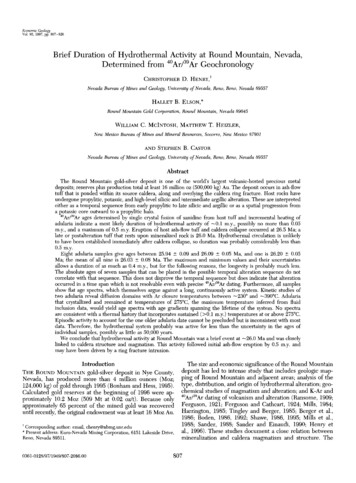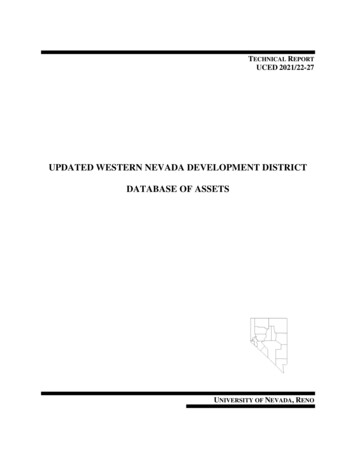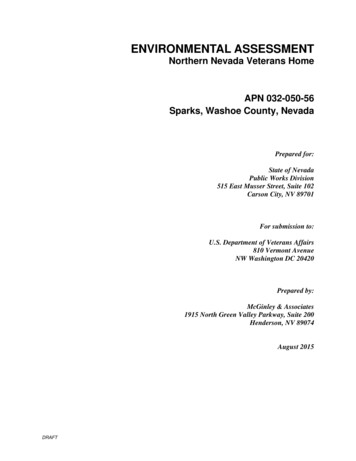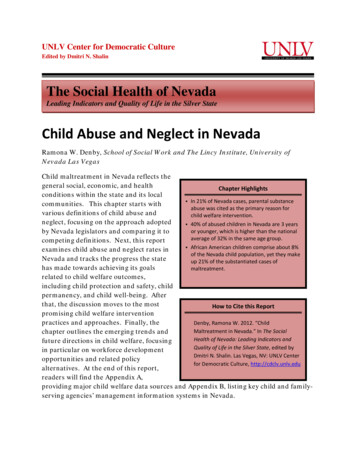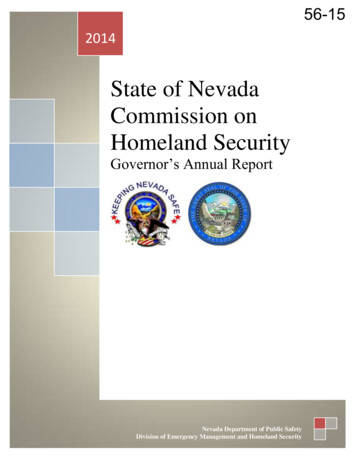
Transcription
56-152014State of NevadaCommission onHomeland SecurityGovernor’s Annual ReportNevada Department of Public SafetyDivision of Emergency Management and Homeland Security
TABLE OF CONTENTSINTRODUCTION .1OVERVIEW AND COMMISSION ACTIVITIES REPORT .2COMMITTEE ACTIVITIES REPORT .7CRITICAL INFRASTRUCTURE COMMITTEE (CIC) .7NEVADA CRITICAL INFRASTRUCTURE PROTECTION PLAN (NCIPP) SUBCOMMITTEE . 9FINANCE COMMITTEE .9LEGISLATIVE AND BYLAWS COMMITTEE .10STATE HOMELAND SECURITY STRATEGY (SHSS) COMMITTEE .10STATE OF NEVADA NETWORK (SONNet) COMMITTEE.11EXECUTIVE ORDER COMMITTEES .12HOMELAND SECURITY WORKING GROUP (HSWG) .12NEVADA COMMUNICATIONS STEERING COMMITTEE (NCSC) .13NEVADA PUBLIC SAFETY COMMUNICATIONS COMMITTEE (NPSCC) .13STATE CITIZEN CORPS PROGRAM.14NEVADA DIVISION OF PUBLIC AND BEHAVIORAL HEALTH, PUBLIC HEALTHPREPAREDNESS .20APPENDIX A – COMMISSION AND COMMITTEE MEMBERSHIP .23NEVADA COMMISSION ON HOMELAND SECURITY .24CRITICAL INFRASTRUCTURE COMMITTEE (CIC) . 25NEVADA CRITICAL INFRASTRUCTURE PROTECTION PLAN SUBCOMMITTEE . 25FINANCE COMMITTEE . 26STATE HOMELAND SECURITY STRATEGY (SHSS) COMMITTEE . 26STATE OF NEVADA NETWORK(SONNet) COMMITTEE . 27HOMELAND SECURITY WORKING GROUP .28NEVADA COMMUNICATIONS STEERING COMMITTEE (NCSC) .29NEVADA COMMUNICATIONS STEERING COMMITTEE 9-1-1 SUBCOMMITTEE . 29i
NEVADA COMMUNICATIONS STEERING COMMITTEE GRANTS SUBCOMMITTEE. 29NEVADA PUBLIC SAFETY COMMUNICATIONS COMMITTEE (NPSCC) .30NEVADA STATE CITIZEN CORPS.31APPENDIX B – PUBLIC MEETING DATES .32COMMISSION AND COMMITTEES .33NEVADA COMMISSION ON HOMELAND SECURITY . 33CRITICAL INFRASTRUCTURE COMMITTEE (CIC) . 33NEVADA CRITICAL INFRASTRUCTURE PROTECTION PLAN COMMITTEE (NCIPP). 33FINANCE COMMITTEE . 33STATE HOMELAND SECURITY STRATEGY COMMITTEE (SHSS) . 33STATE OF NEVADA NETWORK (SONNet) COMMITTEE . 33EXECUTIVE ORDER COMMITTEES & SUBCOMMITTEES .34HOMELAND SECURITY WORKING GROUP (HSWG) . 34NEVADA COMMUNICATIONS STEERING COMMITTEE (NCSC) . 34NEVADA COMMUNICATIONS STEERING COMMITTEE 9-1-1 SUBCOMMITTEE . 34NEVADA COMMUNICATIONS STEERING COMMITTEE GRANTS SUBCOMMITTEE. 34NEVADA PUBLIC SAFETY COMMUNICATIONS COMMITTEE (NPSCC) . 34NEVADA STATE CITIZEN CORPS COUNCIL . 34APPENDIX C – HOMELAND SECURITY GRANT PROGRAM FINANCIAL INFORMATION .35APPENDIX D – PUBLIC MEETING AGENDAS .38NEVADA COMMISSION ON HOMELAND SECURITY .39CRITICAL INFRASTRUCTURE COMMITTEE (CIC) . 51NEVADA CRITICAL INFRASTRUCTURE PROTECTION PLAN COMMITTEE (NCIPP). 57FINANCE COMMITTEE . 59EXECUTIVE ORDER COMMITTEES . 66HOMELAND SECURITY WORKING GROUP . 66NEVADA PUBLIC SAFETY COMMUNICATIONS COMMITTEE (NPSCC) . 70NEVADA STATE CITIZEN CORPS COUNCIL . 78ii
INTRODUCTIONIn 2003 the Nevada Legislature created the Nevada Commission on Homeland Security as a response tothe terror attacks against the United States on September 11, 2001. As described in Chapter 239C of theNevada Revised Statutes (NRS 239C), the Nevada Commission on Homeland Security is tasked withseveral responsibilities directed toward making recommendations to the Governor, the Legislature, localgovernments, private business, and citizens about actions and measures that may be taken to protect thecitizens and visitors to this State from potential acts of terrorism and related emergencies.The duties of the Commission include: Making recommendations to the Governor, Legislature, State agencies, local governments,businesses, and private citizens about actions to be taken to protect against terrorism; Making recommendations, through the Division of Emergency Management, on the use ofmoney received by the State from homeland security grants or related programs; Proposing goals and programs to counteract acts of terrorism; Ensuring the safety of Nevada’s residents and the critical infrastructures of the State byidentifying the susceptibility of those infrastructures to terrorist acts; Examining the use and deployment of response agencies; Reviewing the interoperability of the State’s communications systems and the efficacy ofemergency (911) telephone systems, including establishment of a State plan for the compatibilityand interoperability of the State’s information and communication systems for response agenciesand advising the Governor about such systems with particular emphasis on public safety radiosystems; Coordinating between government agencies to avoid duplication; and Submitting an annual briefing to the Governor on the assessment of the State’s preparedness,including an assessment of response plans and vulnerability assessments of utilities, and publicand private entities.To summarize, the Nevada Commission on Homeland Security has the responsibility to advise theGovernor and the Legislature on any and all means that will improve the safety and security of the State,our residents and visitors.To meet this responsibility the Commission on Homeland Security continues its close partnership withthe Nevada Department of Public Safety, Division of Emergency Management and Homeland Security.The resulting cooperation has allowed the Commission to move forward in its defined duties that areoutlined in the following pages of this report.1
OVERVIEW AND COMMISSION ACTIVITIES REPORTJanuary 1, 2014 to December 31, 2014The Nevada Commission on Homeland Security (the Commission) continued to support funding of riskbased counterterrorism and public safety programs and projects in Nevada. The overall amount ofFederal homeland security grant funds available to Nevada to address preparedness and preventionactivities increased slightly in Federal Fiscal Year (FFY) 2014 from the prior year. Nevada received atotal of 4,733,000 in Homeland Security Grant Program (HSGP) funds in FFY 2014, which representsa 27% increase over funding received in FFY 2013.Nevada’s FFY 2014 HSGP included 3,733,000 allocated to the State Homeland Security GrantProgram (SHSGP) and 1,000,000 to the Urban Area Security Initiative (UASI) program (total 4,733,000). The UASI funding was reinstated for FFY 2014 after being eliminated in FFY 2013.The Commission met in regular session five times in 2014.1 Throughout this series of meetings, theCommission heard several reports and briefings from state and local government officials on the statusof several HSGP funded projects and provided direction to stakeholders on efforts to address local andstatewide preparedness efforts.On February 28, 2014, the Commission unanimously approved seven HSGP project requests totaling 189,283.09 encompassing an array of reobligation, deobligation, and project change requests aimed ataddressing Nevada’s preparedness level. Additionally, the Commission was briefed with an overview ofthe HSGP process for 2014, a review of the FFY 2013 Commission priorities, and summary discussionon the State Preparedness Report (SPR), the Threat and Hazard Identification Risk Assessment(THIRA), and the State Homeland Security Strategy (SHSS). Using this information, theCommissioners were tasked to rank prioritize core capabilities for the state of Nevada to be used toapprove funding for 2014 HSGP projects.On March 21, 2014, The Commission set project and capabilities priorities for the HSGP fundingallocation in line with federal grant guidance. Presidential Policy Directive - 8 (PPD-8), whichdescribes the Nation’s approach to preparing for threats and hazards that pose the greatest risk to thesecurity of the United States. The objective of PPD-8 is to facilitate an integrated, all-of-nation riskinformed, capabilities based approach to preparedness. This is done through a shared responsibilitythroughout all levels of government, including the private sector, nonprofits, and individual citizens.PPD-8 depends on close involvement of state and local government and stakeholders to work with thefederal government to strengthen the security and resilience of the United States through systematicpreparation for the threats and hazards that pose the greatest risk to the security of the Nation, includingacts of terrorism, cyber-attacks, pandemics, and catastrophic natural disasters.1The Commission met on February 28, March 21, May 15, September 22, and December 12, 2014.2
The federal model developed to achieve the outcomes identified in PPD-8, the National PreparednessGoal (NPG), continues to be employed setting forth 31 “core capabilities.” These core capabilitiesrepresent a maturing of the formerly used “target capabilities” to identify preparedness capabilities andestablish project based investments. The core capabilities each represent distinct critical elements toachieve the NPG and are essential for the execution of each of the Goals’ five mission areas (Prevention,Protection, Mitigation, Response, and Recovery). This transition from target capabilities to corecapabilities expands the threat and hazard areas to include mitigation and allows for greater focus onprotection and prevention activities.Based on this federal model, the Commission was presented a detailed overview of the HomelandSecurity Grant Program (HSGP) and Commission priorities set in 2013 by the Chief of the NevadaDivision of Emergency Management. The primary source of this information came from the StatePreparedness Report (SPR), which is an annual self-assessment of state preparedness capabilities.Using the SPR data, and analyzing the perceived gaps, risks, and needs relative to the core capabilities,the Commission established 5 priorities for the HSWG to use in the identification of eligible projects forFFY 2014 HSGP funding. The 5 priorities, ranked highest to lowest, are:Rank12345Core Capability / PriorityCybersecurityIntelligence and Information SharingPublic Information and WarningOperational CoordinationOperational CommunicationsMission AreaProtectionPreventionAllAllResponseThe Commission was also presented a detailed overview of the historical events, efforts applied, andupcoming actions to be taken as a result of the ongoing wireless broadband communications initiativesinvolving the First Responders Network (FirstNet) and the Governor’s Executive Order 2014-01establishing the Nevada Public Safety Communications Committee (NPSCC). That Committee willabsorb the duties of the State of Nevada Network (SONNet) Committee as well as the NevadaCommunications Steering Committee (NCSC) to better align the state in addressing importantcommunications initiatives. The Commissioned moved to dissolve SONNet and move forward withpopulating the new NPSCC membership. NCSC was specifically dissolved via Executive Order 201401.The Commission was also briefed on the Critical Infrastructure Committee (CIC) activities to dateincluding a request from the CIC Chair to allow for a closed session of the June 2, 2014 CIC meetingpursuant to statutory exemption under Nevada Revised Statutes (NRS) 239C.140. The closed sessionwas requested to receive a cybersecurity briefing from a representative from the Department ofHomeland Security. Pursuant to this statutory exemption, the Commission deliberated and approvedallowing a closed session of the June 2, 2014 CIC meeting for the purposed of that committee to hear acyber-security briefing related to critical infrastructure.In addition, the Commission was presented a request to establish a Cyber Security Committee under theCommission to address complex cyber-security issues in addition to providing the state with technicalanswers for such issues. Under this Commission, this Committee could: Create a statewide cyber-security plan;Recommend suggestions for grant funding based on state objectives;Report on the posture of the State to create measurable metrics;3
Enhance understanding around cyber-security by communicating in non-technical terms;Improve the cyber resilience of the state by coordinating cyber professionals and entities andImprove sensitive communications through the authority of the Commission.The Commission discussed at length support of the development of this Committee in addition to howthis Committee’s purview would be separated from the existing CIC.The Commission was also presented with a discussion on proposed changes to the Homeland SecurityWorking Group (HSWG) process and whether changes in the process would be beneficial movingforward as the current process is labor intensive in respect to the reduced amount of money now comingthrough the Homeland Security Grant Program. It was determined that for the grant period in 2014, nochanges would occur with the HSWG process.On May 15, 2014, using the priority criteria established by the Commission for 2014, and with theapproval of the Finance Committee, the Commission voted to move forward with approving 18 StateHomeland Security Program funded projects in addition to two Urban Area Security Initiative (UASI)projects. This allowed the State Administrative Agency (SAA) to submit the Nevada HSGP applicationto DHS representing combined State Homeland Security Grant Program (SHGP) InvestmentJustifications (IJ) totaling 4,496,350. The investments funded are listed below; IJs are in italics (SeeAppendix C for more detail)State Homeland Security Program Funded ProjectsRanking123456789101112131415161718Project FundedSouthern Nevada Counter Terrorism Center – [Intelligence and Information Sharing]Nevada Threat Analysis Center – [Intelligence and Information Sharing]Advanced Persistent (Cyber) Threats Project – [Cybersecurity]Schools Prepared and Ready Together Across Nevada (SPARTAN) – [Operational Coordination]Washoe County Sheriff’s Office – Cyber Security – [Cybersecurity]Public Warning and Public Information – [Public Information and Warning]Statewide Continuity of Operations and Government Sustainment Project – [Operational Coordination]Homeland Security Working Group Process – [Operational Coordination]Statewide NIMS/Preparedness – [Operational Coordination]Advanced CBRNE Detection & Decontamination ARMOR Taskforce – [Operational Coordination]Statewide Citizen Corps Council – [Operational Coordination]Washoe County TRIAD Regional HazMat Team Capability/Sustainment – [Operational Coordination]Northeast Nevada Citizen Corps/CERT Program – [Operational Coordination]Southern Nevada All Hazards Incident Management Team – [Operational Coordination]Southern Nevada CERT – [Operational Coordination]Washoe County Sheriff’s Office Citizen Corp Program – [Operational Coordination]Douglas County CERT Program – [Operational Coordination]Statewide Interoperability Coordinator – [Operational Communications]UASI Only Funded ProjectsRankingn/an/aProject FundedNo. LV Analyst for the So. Nevada Counter Terrorism Center – [Intelligence and Information Sharing]Metro Medical Response System (MMRS) – [Operational Coordination]4
On September 22, 2014, the Commission was briefed by the CIC on recent activities of the Committeeand the State, Local, Tribal, Territorial, and Government Coordinating Council (SLTTGCC) noting thatthe SLTTGCC was actively recruiting new membership in the Region IX area. This region is currentlyunder-represented. Additionally, the CIC briefing spoke to recent efforts surrounding regional resiliencyand the Department of Homeland Security project which was endorsed by the CIC to address resiliencyin relation to waste water treatment capabilities in southern Nevada. The CIC also fully endorsed theCommission on considering the stand alone Cyber Security Committee.The Commission was presented an update on the establishment of the Cyber Security Committee notingmembership recommendations, pursuance of conversations with key stakeholders, and the opportunityto address situational understanding on how this initiative relates to the state, the strategic plan, incidentresponse teams to address cyber threats, and appropriate education to leverage the effectiveness of thisnew Committee. The Commission discussed at length both suggestions and concerns related to thisrequest, and unanimously approved the creation of the Cyber Security Committee.An update by the Director of Public Safety was given to the Commission on the recently establishedNevada Public Safety Communications Committee (NPSCC) in addition to briefing the Commission onthe necessity of ensuring interoperability remain meaningful noting numerous outreach activitiesthroughout the state. A Request for Proposal (RFP) Committee has been appointed to assist the NevadaDivision of Emergency Management staff to acquire an outreach specialist to work with the StatewideInteroperability Coordinator in performance with the State and Local Implementation Grant Program(SLIGP)Additionally, the Commission was briefed with a review of Federal Fiscal Year (FFY) 2011 through2014 HSGP allocations by NDEM as well as a HSGP project report from Northeast Nevada CitizenEmergency Response Team (CERT) coordinator for Elko noting the efforts of citizen first responderswithin the state.On December 12, 2014, the Commission met for a final time to discuss current activities of the CIC, theCyber Security Committee, and to hear an update on the DHS regional resiliency project for southernNevada. The CIC Chair briefed the Commission on current activities including future nominations tothe SLTTGCC as well as reporting a new Chair and Vice-Chair had been elected to the CIC.The Commission was presented a defined scope and sector specific plan for the Cyber SecurityCommittee to include the original key objectives in addition to limiting membership to include 10 votingmembers and two ex-officio members. The makeup of the Committee would be structured as follows: The Chair of the CIC;State of Nevada representative;Representation from both a north and south county within Nevada;Representation from both a north and south city within Nevada;University school system representative;Nevada National Guard representative;Power utility representative;Water utility representative;Nevada Gaming representative;Federal Bureau of Investigation (as an ex-officio member) andDepartment of Homeland Security (as an ex-officio member)5
The Commission discussed at length the proposed structure of membership noting that private sectormembership may also be important to this Committee. The Commission will continue to hear updateson the new Cyber Security Committee structure moving forward.Additionally, the Commission was presented a thorough briefing on the recent activities related to theDepartment of Homeland Security’s Regional Resiliency Assessment Program (RRAP) including anoverview of the RRAP process in general as well as the Southern Nevada RRAP process. The projectfor southern Nevada focuses on cyber and physical systems vital to the operation of key wastewaterreclamation treatment centers.As of December 31, 2014, the Commission has four vacancies. The Commission seat vacated byretiring Fire Chief Bertral Washington, Clark County Fire Department will be filled by appointmentpursuant to NRS 239C.120(2)(b), specifying the chief of the county fire department in each countywhose population is 100,000 or more will be appointed as a voting member of the Commission, servingat the pleasure of the Governor. The Legislative seat vacated by Assemblyman James Healey as a resultof his election loss will be filled by the Speaker of the Assembly pursuant to NRS 239C.120(5). Inaddition, the seats vacated Sheriff Michael Haley, Washoe County Sheriff’s Office, and Sheriff DougGillespie, Las Vegas Metropolitan Police Department will be filled by appointment pursuant to NRS239C.120 (a)(9)(10) specifying the sheriff of each county whose population is 100,000 or more will beappointed by the Governor as voting members of the Commission, serving at the pleasure of theGovernor.The Commission maintains a website with current and past meeting dates, agendas, and meetingminutes. The website can be accessed via http://dem.nv.gov/homeland security/2014 Meetings/.The Commission continues its service to the people of Nevada though its Vision and Mission Statementsto provide “A safe Nevada for its citizens and visitors free from risks, vulnerabilities, and threats,” and“To advise the Governor on actions, measures and funding relating to homeland security for the State ofNevada.”6
COMMITTEE ACTIVITIES REPORTThis section of the Nevada Commission on Homeland Security Annual Report summarizes the activitiesof the committees directly under the Commission (Critical Infrastructure, Finance, Legislative andBylaws, State of Nevada Network (SONNet), and State Homeland Security Strategy) and also includesthe Governor’s Executive Order Committees that advise and make recommendations to the Commission(The Homeland Security Working Group, the Nevada Communications Steering Committee, and theState Citizen Corps Council). The last section summarizes the health preparedness activities of theNevada Health Division and the Nevada Hospital Association. The agendas for all scheduled publicmeetings of the Commission and its Committees can be found in Appendix D.CRITICAL INFRASTRUCTURE COMMITTEE (CIC)The Critical Infrastructure Committee (CIC) is tasked with ensuring that the critical infrastructure assetsof the State of Nevada are identified, properly cataloged, and protected in order to assist in decreasingany compromise of the critical infrastructure system that could potentially have a debilitating impact onthe state either directly, through interdependency, or cascading effects from acts of terror or naturalhazards.The CIC conducts reviews of federal Critical Infrastructure Protection (CIP) guidance and programs toensure they are in line with state and local strategies. The Committee reports to the Commission on thecritical infrastructure (CI) programs within Nevada and how well these programs correlate with DHSguidance and the Commission’s intent. Additionally, the CIC conducts periodic reviews of state andfederal law to identify gaps and obstacles affecting CI protection efforts and makes recommend changesin state or local law to the Commission as appropriate. The CIC met on three occasions in 2014.2On March 13, 2013, the CIC heard an update on recent activities of the SLTTGCC including a requestfor the CIC to reach out for nominations to replace a vacated seat on the SLTTGCC noting that theSLTTGCC serves as a repository for best practices and will be taking on a central role to achieveregional resiliency as tasked by DHS directorate. There is a need for more representation in Region IX.The Committee discussed at length ways in which it can assist the SLTTGCC in best representingNevada’s critical infrastructure needs in addition to the nomination process currently in place for newmembership.The CIC was also briefed with an update by the DHS on the status of Critical Infrastructure and KeyResources (CIKR) activities affecting Nevada including the release of the IP Gateway as the CIKRrepository for critical infrastructure related information in addition to upcoming training opportunities2The CIC met on March 13, 2014, June 10, 2014, and December 1, 2014.7
and upcoming regional resiliency assessments including focus on impact to critical infrastructure as aresult of a large earthquake.Additionally, the CIC was presented discussion on the necessity to include sector-specific councillanguage in the current Nevada Critical Infrastructure Protection Plan (NCIPP) by the NCIPP Chair.Focus was placed on the influence of the National Infrastructure Protection Plan (NIPP) has on thecurrent NCIPP with regard to sector-specific councils. The CIC unanimously moved to strike sectorspecific coordinating council language from the NCIPP with the intention of bringing forth a new draftwith new language reflecting the direction Nevada wishes to take.On June 10, 2014, the CIC was briefed on the annual SLTTGCC meeting in Arlington, Virginia notingthere is heavy emphasis between physical and cyber security, increasing private and public partnerships,and engaging the private sector. Discussion ensued regarding the positive effects of feedback from theRegional Resiliency Assessment Program (RRAP) to DHS in addition to a reported delay in theimplementation of the IP Gateway system till December 2014. The CIC discussed at length thenomination process currently in place for SLTTGCC membership.The CIC was also briefed with an update by the DHS on the status of Critical Infrastructure and KeyResources (CIKR) activities affecting Nevada including the status of the IP Gateway project noting thatthe Automated Critical Asset Management System (ACAMS) was no longer online, though informationwithin that system was retrievable through protected critical infrastructure protection (PCII) guidelines.Emphasis was placed on this gap in current PCII storage, and that authorized administrative personnelwould be set up with appropriate training. Additionally, discussion was also presented by DHS onnominating project assessments to the RRAP. DHS asked for 50 projects to be conducted within theUnited States, with five having a cyber-component included in the project. As a result, thedetermination was made that there would be an exercise addressing scenarios that would impactwastewater treatment. A draft of that project was submitted to the DHS regional director with approvalset for fall of 2014, and the project would start in 2015.Additionally, the CIC discussed the development of the Cyber Security Committee as a committee underthe Nevada Commission on Homeland Security. The CIC was briefed on the complexities of cybersecurity and the current challenges affecting Nevada, noting that the Commission had placed cybersecurity as their number one priority for the state. Emphasis was placed on the fact that Nevada musthave a coordinated response and governance model to address real threats, and that the Cybe
Federal homeland security grant funds available to Nevada to address preparedness and prevention activities increased slightly in Federal Fiscal Year (FFY) 2014 from the prior year. Nevada received a total of 4,733,000 in Homeland Security Grant Program (HSGP) funds in FFY 2014, which represents a 27% increase over funding received in FFY 2013.
